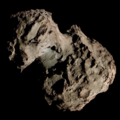 Comet Kopff photographed from a 14" reflector telescope on 27 June 2009 | |
| Discovery | |
|---|---|
| Discovered by | August Kopff |
| Discovery site | Königstuhl Observatory |
| Discovery date | 23 August 1906 |
| Designations | |
| P/1906 Q1 P/1919 O1 | |
| |
| Orbital characteristics [1] | |
| Epoch | 31 March 2024 (JD 2460400.5) |
| Observation arc | 117.6 years |
| Number of observations | 5,043 |
| Aphelion | 5.32 AU |
| Perihelion | 1.54 AU (epoch 2024) 1.32 AU (real-world) [2] [a] |
| Semi-major axis | 3.43 AU |
| Eccentricity | 0.551 |
| Orbital period | 6.357 years |
| Inclination | 4.753° |
| 120.58° | |
| Argument of periapsis | 162.92° |
| Mean anomaly | 115.26° |
| Last perihelion | 18 March 2022 |
| Next perihelion | 28 June 2028 [2] |
| TJupiter | 2.866 |
| Earth MOID | 0.539 AU |
| Jupiter MOID | 0.08 AU [3] |
| Physical characteristics | |
Mean radius | 1.89±0.18 km [4] |
| 12.3±0.8 hours [5] | |
| 0.042±0.01 [6] | |
| Comet total magnitude (M1) | 11.9 |
Comet Kopff or 22P/Kopff is a Jupiter-family comet with a 6.36-year orbit around the Sun. Discovered on 23 August 1906, it was named after its discoverer, August Kopff. The comet was missed on its November 1912 return, but was recovered on June 1919 and has been seen at every apparition since. [7] Close approaches to Jupiter in 1938 and 1943 [3] decreased the perihelion distance and orbital period. [8] [9] 22P/Kopff’s last perihelion passage was 18 March 2022. [1]
Contents
It will pass 0.439 AU (65.7 million km) from Jupiter on 25 April 2026, [3] then come to perihelion on 28 June 2028 at 1.32 AU from the Sun, [2] and then pass 0.353 AU (52.8 million km) from Earth on 13 July 2028. [3]


